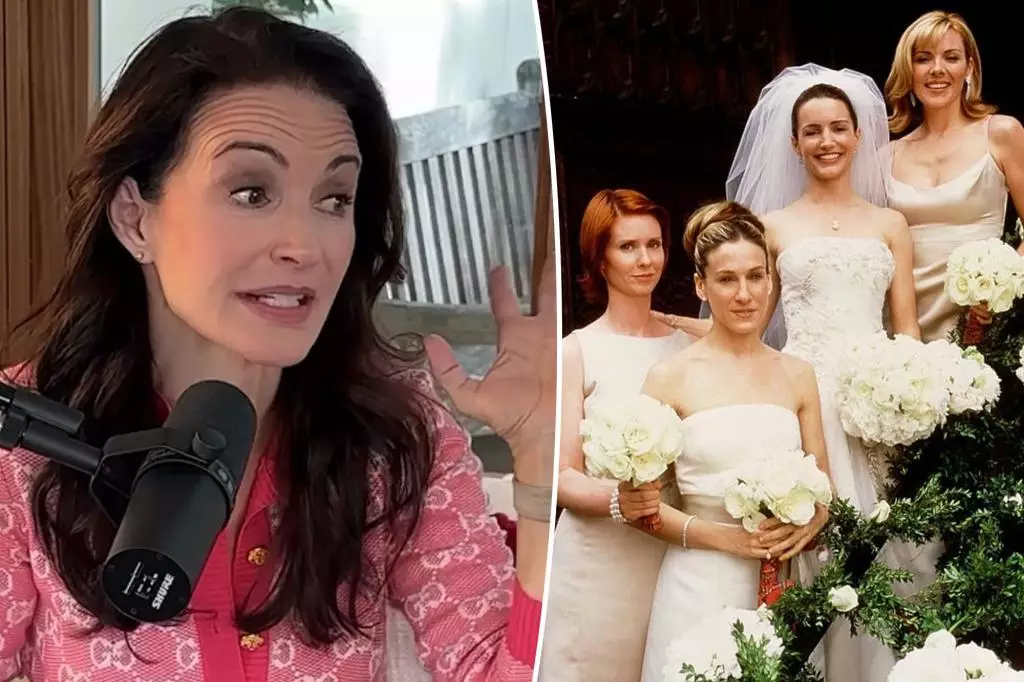The beloved television series “Sex and the City” not only provided entertainment but also gave us iconic fashion moments that have continued to resonate with fans. However, behind the scenes, the cast encountered their fair share of disputes, particularly concerning wardrobe choices. Kristin Davis, known for her portrayal of Charlotte York, recently opened up about a clash between her and fellow star Sarah Jessica Parker, who played the series’ central character, Carrie Bradshaw. This incident, stemming from a bridesmaid dress, illustrates how deeply intertwined fashion is with character development and personal expression in storytelling.
During a recent episode of her podcast, Davis revealed that Parker was reportedly still harboring frustration over the beige bridesmaid dress she wore for Charlotte’s wedding to Trey MacDougal. According to Davis, who shared her memories with the show’s executive producer Michael Patrick King, Parker’s distaste for the dress was so profound that it led her to make alterations to it on set. Such actions not only highlight the actresses’ commitment to their personal aesthetics but also reveal a fundamental aspect of their characters. Carrie Bradshaw, known for her bold and fashion-forward choices, found herself in a gown that didn’t align with her vibrant persona. This choice of wardrobe could suggest deeper themes surrounding individuality and conformity within the narratives created by the series.
King reflected on the complexities of filming this particular episode, describing it as one of the most arduous days of production. This strenuous experience, intertwined with an atmosphere of dissatisfaction regarding costume choices, led to tensions that could affect the overall dynamic on set. Parker’s drastic decision to cut the Vera Wang dress and incorporate tartan, reminiscent of Trey’s traditional kilt, speaks volumes about her character’s resolve to infuse her own identity into a role designed to support Charlotte’s storyline. This anecdote not only sparks intrigue about the creative processes behind character portrayal but also sheds light on the very human nature of artistic expression—where even established stars grapple with fitting into roles that may not fully encapsulate their spirit.
Davis’ recounting of Parker’s venting sessions adds another layer of complexity to their on-screen dynamic. The dialogue between the two actresses—where Davis insisted that the bridesmaid dress should logically match Charlotte’s wedding aesthetic—demonstrates a critical interplay between the characters and the actors behind them. With each character representing different aspects of femininity and friendship, their wardrobe choices heavily influence the audience’s perception of their relationships. The decisions made in costume can often signal deeper narrative choices, illustrating character development in both poignant and sometimes comical ways.
Later in their discussion, Davis highlighted the absence of uniformity in dresses during Carrie’s wedding to Mr. Big in the film adaptation of “Sex and the City.” This notably diverges from the bridesmaids’ coordinated looks during Charlotte’s wedding, suggesting an evolution in the series’ narrative approach to weddings and friendships. In the sequel, the absence of matching costumes reinforces the idea of individuality and personal expression. This shift can be viewed as a broader commentary on the maturation of the characters and their willingness to embrace their unique identities, even within the framework of friendship.
The drama surrounding the bridesmaid dress serves as a compelling reflection on the intersection of fashion, character alignment, and the creative processes of actors within “Sex and the City.” As Davis and King reminisce about their experiences on set, they unveil a tapestry woven with the threads of artistic expression, wardrobe disputes, and the importance of individuality in storytelling. Fashion, as demonstrated through the lens of this iconic series, plays a critical role not only in character identity but also in forging connections among the actresses, who navigate both the challenges and triumphs of portraying complex, relatable women. In the world of “Sex and the City,” every stitch and fabric choice resonates beyond the screen, making it a continuing source of discussion among devoted fans and fashion enthusiasts alike.

